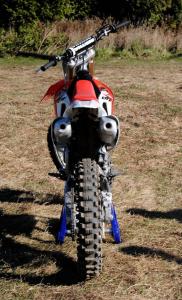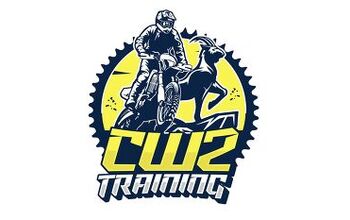2013 Honda CRF450R Review - Motorcycle.com
Back in 1997, Honda broke the motocross bike mold with the introduction of its aluminum-frame CR250R motocrosser. Although the bike was met with mixed reviews, it was the beginning of a new era in the design of dirt bikes. Honda again went back to the drawing board in 2009 and released an all-new CRF450R, complete with EFI, a new frame and a whole new look. I remember being completely blown away by its appearance the first time I saw it.
Now, after three years of refinements, Honda has once again changed things up and has introduced a new CRF450R for 2013, boasting major changes to its frame, a new KYB Pneumatic Spring Fork (PSF), a dual-canister exhaust, a six-spring clutch and new plastics and graphics. This bike has been redesigned from the ground up and tested by riders like Jeremy McGrath to make sure that it is ready to race.
Let’s begin with the 48mm KYB PSF fork that uses air to replace conventional coil springs. It’s nearly two pounds lighter than the old fork and Honda says it operates with less friction. An air chamber inside functions as a spring. If you need the forks stiffer, you simply add air through a valve located on the top of the fork cap to deliver a stiffer ride within minutes. Conversely, if you need a little softer ride, bleeding a bit of air out of the fork is all it takes. Honda technicians tell us that a 2 psi change either way equals one coil spring rate. It is a simple and ingenious system that works very well on the track.
The next change we’ll look at is the modifications made to the frame. While most other 450 manufacturers have been trying to find ways to make their frames stiffer, Honda has actually been going the other way. One of the complaints about the CRF450R the last few years has been that the frame was a bit too rigid and that there was too much weight distributed to the front end. This created a “stink bug” feel to the bike and made it tough to handle when tracks got rough. To fix this, Honda has made a few changes to the frame, particularly to the steering head area, designed to alleviate the feeling of the bike being front-wheel heavy while also allowing the frame to flex more, therefore giving the rider more feel on the track.
Another change to the frame comes with the addition of the new dual exhaust system. This new system allows the 2013 CRF450R to put out strong power while running at a very quiet 94db. And having shorter mufflers on each side of the bike moves the entire exhaust system closer to the bike's center of mass. At a purported 237 pounds, the 2013 CRF450R is the lightest of all the 450s.
Other changes to this bike include a new piston, revised porting and valve timing, and a bump in compression. Although these changes have given the bike more overall power, it has also made the power delivery smoother and easier to handle. Honda has also given this bike a heavier flywheel and a new six-spring clutch pack, which has made the CRF harder to stall and has increased clutch durability.
I’ve been riding a lot of Hondas for the last few years and have become very familiar with the good and bad handling characteristics of the CRF450R. While few other bikes on the market have cornered as well as the Honda, its handling on rough tracks has been a trouble spot. The changes made to the 2013 CRF450R aim to fix these problems.
I first noticed this new bike felt a little bit taller than past models. Since 2009 I’ve felt like the CRF450R has catered to shorter riders. I am not sure exactly why, but it might be because taller riders end up putting too much weight over the front end, thus making the handling problems even worse.
The new CRF has very neutral handling characteristics on rough sections of the track while not giving up any of its superior cornering abilities. Part of this improvement is due the new pneumatic spring fork that delivers incredibly smooth action. The harshness of the old front end is gone, and the ease with which these new air forks can be adjusted make it the most exciting new feature since EFI was introduced back in 2009. Simply changing air pressure can dramatically alter the dynamics of the front suspension.
And when you consider how easy it is to change the ignition mapping, along with the quick adjustability of these new forks, the 2013 CRF450 is the most rider-friendly Honda motocross bike in history.
I was able to test the CRF on two very different types of tracks so I could get a complete feel for how the bike worked. The first track I rode had a tight, Supercross-type layout, which gave a good venue to see if the 2013 model cornered as well and felt as agile as past CRF450Rs have. This new bike certainly didn’t disappoint. In fact, I believe it corners even better than any CRF450R since 2009.
Its handling is a lot more stable and predictable over the braking bumps sometimes found on the entrance into a corner, whether it is a tight Supercross track or a rough outdoor track. The fork and frame now work in unison to give the rider a more precise feel. Over jumps, this new bike is everything you would expect from a Honda.
As the lightest 450 on the market, the CRF450 is extremely maneuverable in the air. Honda claims it was designed for a new generation of rider called “generation scrub” for how modern riders try to stay low off jumps, as innovated by James Stewart in what became known as the Bubba Scrub. This bike accomplishes exactly what Honda wanted, and riders of all abilities will enjoy how it handles in the air.
Ridden on a rough, loamy outdoor track with lots of elevation changes the CRF450 also excelled. Its handling, stability and rider-friendliness coming to the fore. It’s very predictable even on steep, choppy downhills.
The changes to its motor have also made the power on this bike so easy to use. The goal with any 450 powerplant these days is to mellow out the throttle response and make it as easy to ride as possible, and the 2013 CRF does this right out of the crate. You can roll on the throttle and the response doesn’t rip your arms off.
The time I spent riding the 2013 CRF450R certainly made me appreciate the changes Honda has made, as the bike worked very well in all of the conditions. Just when you think that motocross bikes have reached their limit as far as changes and development goes, Honda goes one step further and releases a bike like this.
At $8440 MSRP, the 2013 CRF450R is competitively priced. In fact, it rings in $259 less than Kawasaki’s KX450F ( tested here) and Suzuki’s RMZ-450.
Honda has really come through with its new-generation CRF450R, providing improved handling and exemplary rider-friendliness.
Related Reading
2010 Honda CRF450R Review
2013 Kawasaki KX450F Review
2012 Yamaha WR450F Review
2011 Husaberg FX450 Review
2010 Suzuki RMX450Z Review
2010 Yamaha YZ450F Review
More by Chris Pomeroy



































Comments
Join the conversation